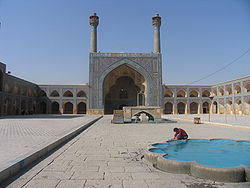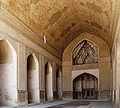- Jameh Mosque of Isfahan
-
Jāmeh Mosque of Isfahān 
مسجد جامع اصفهان
Basic information Location  Isfahān, Iran
Isfahān, IranGeographic coordinates 32°40′10″N 51°41′6″E / 32.66944°N 51.685°ECoordinates: 32°40′10″N 51°41′6″E / 32.66944°N 51.685°E Affiliation Shia Islam Province Isfahān Province Municipality Isfahān County Architectural description Architectural type Mosque Completed 8th century This article is about Jameh Mosque of Isfahan; for similar uses, see Jameh Mosque (disambiguation).The Jāmeh Mosque of Isfahān (Persian: مسجد جامع اصفهان – Masjid-e-Jāmeh Isfahān) is the grand, congregational mosque (Jāmeh) of Isfahān city, within Isfahān Province, Iran. The mosque is the result of continual construction, reconstruction, additions and renovations on the site from around 771 to the end of the 20th century. The Grand Bazaar of Isfahan can be found towards the southeast wing of the mosque.
Contents
Specifications
This is one of the oldest mosques still standing in Iran, and it was built in the four-iwan architectural style, placing four gates face to face. An iwan is a vaulted open room. The qibla iwan on the southern side of the mosque was vaulted with muqarnas during the thirteen hundreds. Muqarnas are niche-like cells.[1]
Construction under the Seljuqs included the addition of two brick domed chambers, for which the mosque is renowned. The south dome was built to house the mihrab in 1086–87 by Nizam al-Mulk, the famous vizier of Malik Shah, and was larger than any dome known at its time. The north dome was constructed a year later by Nizam al-Mulk's rival Taj al-Mulk. The function of this domed chamber is uncertain. Although it was situated along the north-south axis, it was located outside the boundaries of the mosque. The dome was certainly built as a direct riposte to the earlier south dome, and successfully so, claiming its place as a masterpiece in Persian architecture for its structural clarity and geometric balance. Iwans were also added in stages under the Seljuqs, giving the mosque its current four-iwan form, a type which subsequently became prevalent in Iran and the rest of the Islamic world.
Responding to functional needs of the space, political ambition, religious developments, and changes in taste, further additions and modifications took place incorporating elements from the Mongols, Muzzafarids, Timurids and Safavids. Of note is the elaborately carved stucco mihrab commissioned in 1310 by Mongol ruler Oljaytu, located in a side prayer hall built within the western arcade. Safavid intervention was largely decorative, with the addition of muqarnas, glazed tilework, and minarets flanking the south iwan.
The cupolas and piers that form the hypostyle area between the iwans are undated and varied in style, endlessly modified with repairs, reconstructions and additions.[2]
The origins of this mosque lie in the 8th century, but it burnt down and was rebuilt again in the 11th century and went through remodeling many times. As a result it has rooms built in different architectural styles, so now the mosque represents a condensed history of the Iranian Architecture.
Gallery
See also
 Media related to Masjed-e Jomeh, Isfahan at Wikimedia Commons
Media related to Masjed-e Jomeh, Isfahan at Wikimedia CommonsReferences
- ^ Stokstad, Marilyn (2007). Art: a Brief History (3rd ed.). Upper Saddle River: Pearson Education, Inc.. p. 201.
- ^ Archnet Digital Library
 Agha Bozorg Mosque • Al-Nabi Mosque, Qazvin • Atigh Jame' Mosque • Ayatullah Khomeini Mosque • Blue Mosque, Tabriz • Fatima al-Masumeh Shrine • Goharshad Mosque • Hajj Shahbazkhan Mosque • Imām Ridhā Mosque • Imamzadeh Hamzah, Tabriz • Imamzadeh Ja'far, Borujerd • Imamzadeh Saleh, Shemiran • Jameh Mosque of Borujerd • Jameh Mosque of Ferdows • Jameh Mosque of Isfahan • Jameh Mosque of Nain • Jameh Atiq Mosque of Qazvin • Jameh Mosque of Saveh • Jameh Mosque of Tabriz • Jameh Mosque of Yazd • Jameh Mosque of Zanjan • Jamkaran • Monar Jonban • Nasir al-Mulk Mosque • Ribat-i Sharaf • Shāh Abdol Azīm Mosque • Shah Cheragh • Shah Mosque • Sheikh Lotf Allah Mosque • Soltani Mosque of Borujerd • Vakil Mosque • Jameh Mosque of Ashtarjan
Agha Bozorg Mosque • Al-Nabi Mosque, Qazvin • Atigh Jame' Mosque • Ayatullah Khomeini Mosque • Blue Mosque, Tabriz • Fatima al-Masumeh Shrine • Goharshad Mosque • Hajj Shahbazkhan Mosque • Imām Ridhā Mosque • Imamzadeh Hamzah, Tabriz • Imamzadeh Ja'far, Borujerd • Imamzadeh Saleh, Shemiran • Jameh Mosque of Borujerd • Jameh Mosque of Ferdows • Jameh Mosque of Isfahan • Jameh Mosque of Nain • Jameh Atiq Mosque of Qazvin • Jameh Mosque of Saveh • Jameh Mosque of Tabriz • Jameh Mosque of Yazd • Jameh Mosque of Zanjan • Jamkaran • Monar Jonban • Nasir al-Mulk Mosque • Ribat-i Sharaf • Shāh Abdol Azīm Mosque • Shah Cheragh • Shah Mosque • Sheikh Lotf Allah Mosque • Soltani Mosque of Borujerd • Vakil Mosque • Jameh Mosque of Ashtarjan Category – Islam in Iran – Mosques by country
Category – Islam in Iran – Mosques by country Isfahan Province
Isfahan ProvinceCapital Isfahan
Counties (A-L)
and CitiesAran va Bidgol CountyBorkhar CountyDowlatabad • Dastgerd • Habibabad • Khvorzuq • Komeshcheh • ShahpurabadChadegan • RozvehFalavarjan • Abrisham • Baharan Shahr • Imanshahr • Kelishad va Sudarjan • Pir Bakran • Qahderijan • ZazeranFaridan CountyFereydunshahr • Barf AnbarGolpayegan • Golshahr • GugedIsfahan • Baharestan • Ezhiyeh • Harand • Hasanabad • Khvorasgan • Kuhpayeh • Mohammadabad • Nasrabad • Nikabad • Sejzi • Tudeshg • VarzanehKhomeyni Shahr CountyKhomeyni Shahr • Dorcheh Piaz • KushkKhur and Biabanak CountyKhur • JandaqKhvansar CountyKhvansarZarrin Shahr • Bagh-e Bahadoran • Chamgardan • Charmahin • Fuladshahr • Sedeh Lenjan • Varnamkhast • Zayandeh RudCounties (M-Z)
and CitiesSemirom • Hana • Komeh • VanakShahin Shahr and Meymeh CountyShahin Shahr • Gaz • Meymeh • VazvanTiran and Karun CountyTiran • Asgaran • RezvanshahrLandmarks
and
SightsSemirom waterfall • Abyaneh • Niasar fire temple • Atashgah • Babapir • Gogad citadel • Yazdgerd's palace • Grand Bazaar, Esfahan • Kashan Bazaar • Fin Garden • Khaju Bridge • Tappeh Sialk • Si-o-se Pol • Ali Qapu • Shahghandab cave • Mashhad_Ardehal ceremony • Maranjab caravansary • Hasht Behesht • Vank Cathedral • Chahar Bagh School • Qamsar rose water ceremony • Jameh Mosque of Ashtarjan • Jameh Mosque of Isfahan • Shah Mosque • Sheikh Lotf Allah Mosque • Manar Jonban • Naqsh-e Jahan Square • Narin ghaleh • Sultan Amir Ahmad Bathhouse • Agha Bozorg Mosque • Boroujerdi ha Residence • Tabatabaie Residence • House of the Āmeri family • Abbasian House • Chahar Bagh • New JulfaArchitecture of Iran Styles Parsi style · (includes Pre-Parsi style and Achaemenid architecture)
Parthian style · (includes Sassanid architecture)
Khorasani style · Razi style · Azari style · Isfahani style
Elements Notable traditional cities Architecture of Tehran · Bam · Bukhara · Ctesiphon · Derbent · Herat · Isfahan · Kashan · Merv · Mashhad · · Nishapur · Persepolis · Qazvin · Qom · Samarkand · Shahrisabz · Shiraz · Susa · Tabriz · Takht-i-Suleiman · Yazd · Gur-e AmirTheory and Analysis Lists Categories:- 8th-century mosques
- Mosques in Isfahan
- Iranian architecture
Wikimedia Foundation. 2010.








